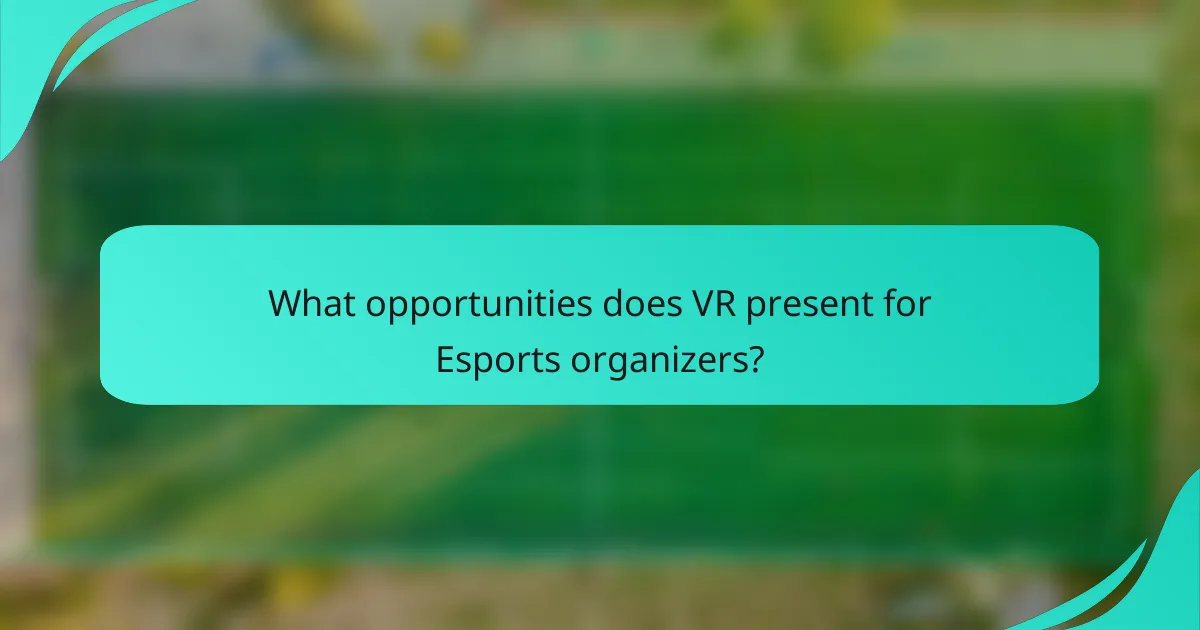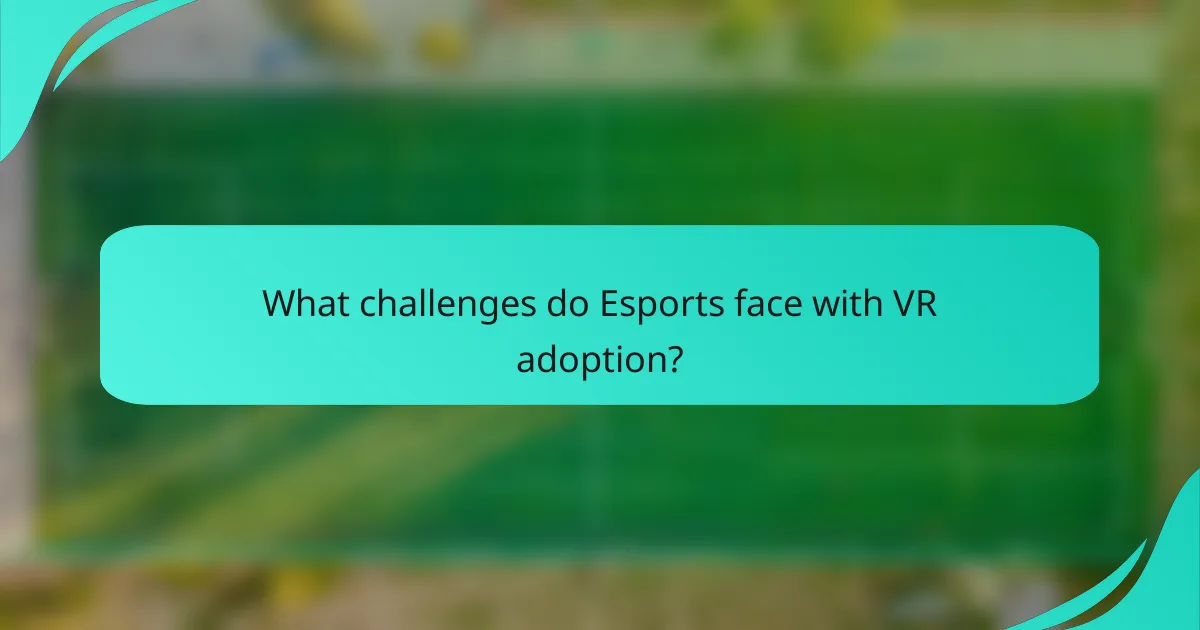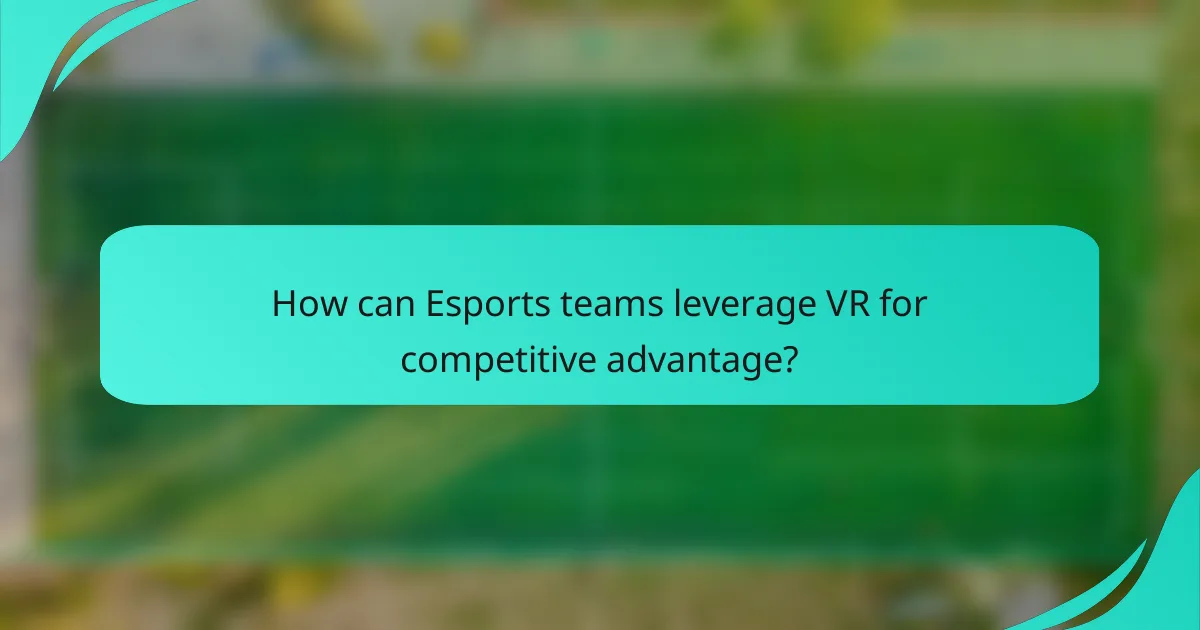The future of virtual reality in esports events is poised for remarkable transformation, offering immersive environments that elevate both player training and spectator engagement. With innovative advancements in VR technology, the potential for enhanced gameplay experiences and expanded audience reach presents exciting opportunities for organizers and fans alike.

How is Virtual Reality transforming Esports events?
Virtual Reality (VR) is significantly transforming Esports events by creating immersive environments that enhance both spectator experiences and player training. This technology allows fans to engage with games in unprecedented ways, while players can practice in realistic settings that simulate actual competition scenarios.
Immersive spectator experiences
VR technology enables spectators to feel as though they are part of the action, providing a 360-degree view of the event. Fans can choose their vantage point, whether it’s from the front row or a bird’s-eye view, making the experience more engaging than traditional viewing methods.
Additionally, VR can integrate interactive elements, such as virtual meet-and-greets with players or behind-the-scenes tours, enhancing the overall enjoyment for fans. This level of immersion can lead to increased loyalty and spending among viewers.
Enhanced player training environments
Players can utilize VR for training, allowing them to practice in simulated environments that mimic real-world scenarios. This technology can help players develop strategies and improve their reflexes without the pressure of live competition.
Training in VR can also be tailored to individual needs, focusing on specific skills or weaknesses. For instance, players can engage in drills that replicate high-stakes situations, helping them to prepare mentally and physically for actual matches.
Real-time data visualization
VR can present real-time data visualization during Esports events, allowing players and coaches to analyze performance metrics instantly. This can include statistics like player movements, reaction times, and decision-making processes displayed in an immersive format.
Such data can enhance strategic discussions during breaks or post-match analyses, providing teams with valuable insights that can inform future gameplay. This immediate access to information can be a game-changer for competitive teams looking to refine their strategies.
Increased fan engagement
Virtual Reality fosters increased fan engagement by creating interactive experiences that go beyond passive viewing. Fans can participate in virtual events, such as tournaments or community challenges, which can enhance their connection to the game and its players.
Moreover, VR can facilitate social interactions among fans, allowing them to connect in virtual spaces, share experiences, and build communities. This sense of belonging can encourage fans to invest more time and resources into their favorite Esports.
Virtual arenas and venues
VR allows for the creation of virtual arenas and venues that can host Esports events without the limitations of physical space. These virtual environments can be designed to accommodate thousands of spectators, providing a unique atmosphere that enhances the viewing experience.
Additionally, virtual venues can reduce costs associated with physical locations, such as renting space or logistics. This flexibility can lead to more frequent events and broader accessibility for fans around the world, regardless of their geographical location.

What innovations are driving the future of VR in Esports?
The future of virtual reality in esports is being shaped by several key innovations that enhance gameplay and spectator experiences. These advancements not only improve immersion but also expand the possibilities for competitive gaming.
Advancements in VR hardware
Recent developments in VR hardware, such as higher resolution displays and improved motion tracking, are crucial for creating more immersive esports experiences. Devices like the latest VR headsets offer enhanced field of view and reduced latency, which are essential for competitive play.
Additionally, ergonomic designs and wireless capabilities allow players to engage in longer sessions without discomfort, making VR a more viable option for esports tournaments. Brands are continuously innovating to provide lightweight and comfortable gear that meets the demands of professional gamers.
Integration of AI and machine learning
AI and machine learning are increasingly being integrated into VR esports to enhance gameplay dynamics and spectator engagement. These technologies can analyze player behavior in real-time, offering insights that help improve strategies and performance.
For example, AI can create adaptive difficulty levels that adjust based on player skill, ensuring a challenging yet enjoyable experience. Moreover, machine learning algorithms can personalize viewer experiences by recommending content based on individual preferences, making esports more engaging for fans.
5G technology enabling seamless experiences
The rollout of 5G technology is a game-changer for VR in esports, providing the high-speed connectivity necessary for real-time interactions. With low latency and high bandwidth, 5G allows for smoother gameplay and more responsive controls, which are critical in competitive settings.
This technology also facilitates cloud gaming, enabling players to access high-performance VR games without the need for expensive hardware. As 5G networks expand, the potential for large-scale VR esports events becomes more feasible, allowing for broader participation and audience reach.
Cross-platform compatibility
Cross-platform compatibility is essential for the growth of VR in esports, allowing players from different systems to compete against each other. This innovation fosters a larger community and encourages more players to participate in VR esports competitions.
Developers are increasingly focusing on creating games that support multiple platforms, ensuring that gamers can connect regardless of their device. This inclusivity not only enhances the competitive landscape but also attracts a diverse audience, further driving the popularity of VR in esports.

What opportunities does VR present for Esports organizers?
Virtual reality (VR) offers Esports organizers numerous opportunities to enhance events, engage audiences, and generate revenue. By integrating VR technology, organizers can create immersive experiences that attract sponsors and broaden their reach to global audiences.
New revenue streams through virtual sponsorships
VR opens up innovative avenues for sponsorships, allowing brands to create interactive advertisements within the virtual environment. For instance, companies can sponsor virtual arenas or player avatars, providing a unique branding experience that traditional advertising cannot match.
Esports organizers should consider offering tiered sponsorship packages that include VR elements, such as branded virtual merchandise or exclusive in-game experiences. This can lead to increased revenue as brands seek to capitalize on the growing popularity of VR among gamers.
Global audience reach expansion
With VR, Esports events can transcend geographical boundaries, enabling fans from around the world to participate in real-time. This technology allows for a more inclusive experience, where players and spectators can interact as if they were physically present, regardless of their location.
Organizers can leverage this global reach by hosting VR tournaments that attract international participants and viewers. Promoting events through social media and VR platforms can further enhance visibility and engagement, leading to a larger audience base.
Creation of unique content experiences
VR allows Esports organizers to craft distinctive content experiences that captivate audiences. This can include behind-the-scenes access to player training sessions or immersive storytelling that enhances the narrative of the competition.
To maximize the impact of these unique experiences, organizers should focus on high-quality production and user-friendly interfaces. Engaging content not only retains viewer interest but also encourages sharing and interaction, amplifying the event’s reach and appeal.

What challenges do Esports face with VR adoption?
Esports face several challenges with virtual reality (VR) adoption, including high costs, technical limitations, and user accessibility issues. These factors can hinder the widespread integration of VR technology in competitive gaming environments.
High costs of VR technology
The initial investment for VR technology can be substantial, often exceeding several hundred to thousands of dollars per setup. This includes not only the VR headsets but also powerful gaming PCs or consoles capable of running VR applications smoothly.
Additionally, ongoing costs such as software licenses and maintenance can add to the financial burden. For many esports organizations, especially smaller teams, these expenses can be prohibitive, limiting their ability to adopt VR solutions.
Technical limitations and infrastructure needs
Technical limitations such as latency and graphical fidelity can significantly impact the VR experience in esports. High latency can lead to motion sickness and a poor user experience, which is critical in competitive settings where every millisecond counts.
Moreover, the infrastructure required for VR, including high-speed internet and dedicated physical space for movement, is often lacking in traditional esports venues. This can complicate the logistics of hosting VR-based tournaments.
User accessibility and comfort issues
User accessibility is a major concern, as not all players have the physical space or equipment needed for VR gaming. Many potential participants may also experience discomfort or motion sickness when using VR headsets, which can deter them from engaging in VR esports.
Furthermore, the learning curve associated with VR technology can be steep for new users. Ensuring that players are comfortable and familiar with the technology is essential for a successful transition to VR in competitive gaming.

How can Esports teams leverage VR for competitive advantage?
Esports teams can leverage virtual reality (VR) to gain a competitive edge by enhancing training, improving team communication, and creating immersive fan experiences. By integrating VR technology, teams can simulate real-game scenarios, allowing players to practice in a controlled environment and refine their skills effectively.
Training and Skill Development
VR can transform training by providing realistic simulations that mimic in-game situations. Players can practice their reflexes, decision-making, and teamwork without the pressure of a live match. This method allows for repeated practice of specific scenarios, helping players to improve their performance over time.
Teams should consider using VR platforms that offer customizable training modules tailored to their specific game. These platforms can help players identify weaknesses and track their progress through performance analytics, making training more efficient and targeted.
Enhanced Team Communication
Virtual reality can facilitate better communication among team members, especially in remote settings. By using VR meeting spaces, players can interact in a more engaging environment, which can enhance collaboration and strategy discussions. This immersive experience can help build team cohesion and improve overall performance.
Esports teams can utilize VR tools that allow for real-time strategy planning and analysis, enabling players to visualize tactics and positioning in a three-dimensional space. This can lead to more effective teamwork and quicker adaptation during matches.
Immersive Fan Experiences
VR technology can create unique experiences for fans, allowing them to engage with their favorite teams and players in innovative ways. For example, VR can offer virtual stadium tours, behind-the-scenes access, or even the ability to watch matches from a player’s perspective. This level of immersion can deepen fan loyalty and attract new audiences.
Teams should explore partnerships with VR developers to create exclusive content and experiences that can be monetized. By offering VR experiences at events or through subscription services, teams can generate additional revenue streams while enhancing fan engagement.
